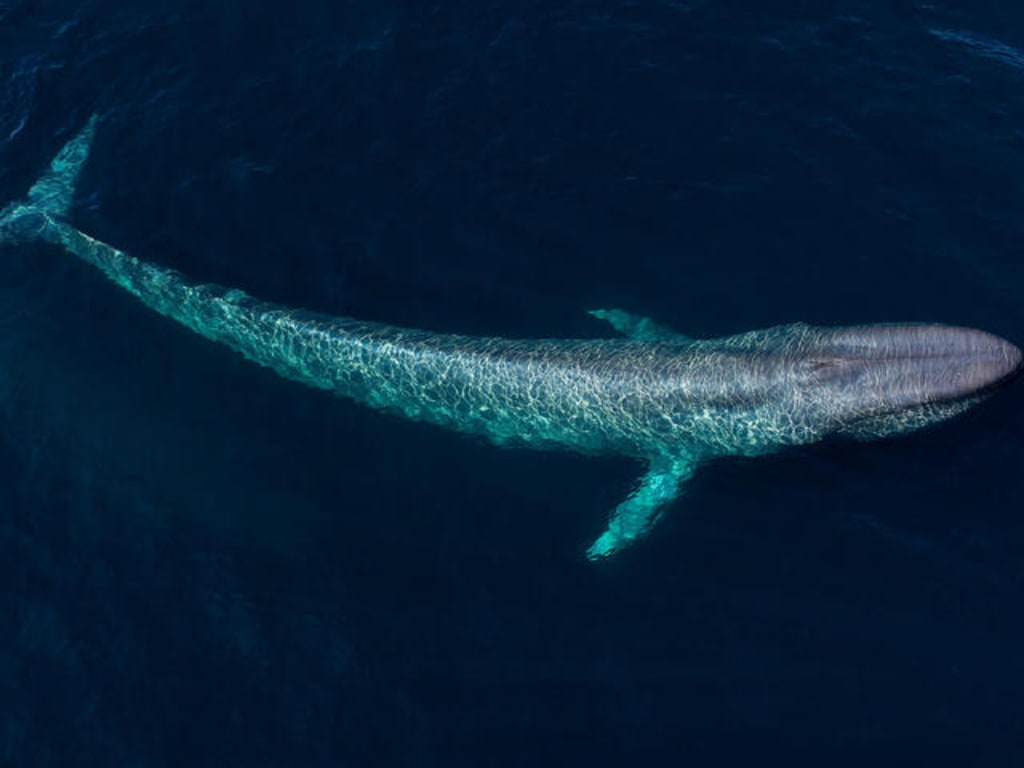
Description
The blue whale possesses a slender physique and a wide U-shaped head. It has thin, elongated flippers and a small sickle-shaped dorsal fin measuring approximately 33 centimeters (13 in) in length, which is situated near the tail. At the base of its wide and thin flukes, there is a substantial tail stock.
The upper jaw of the blue whale is adorned with 70–395 black baleen plates. In the throat region, there are 60–88 grooves that allow the skin to expand while feeding. This magnificent creature possesses two blowholes that can expel water up to a height of 9.1–12.2 meters (30–40 ft). Its skin exhibits a mottled grayish-blue coloration, appearing blue when submerged underwater.
The mottling patterns near the dorsal fin may differ among individuals. The underbelly of the blue whale displays lighter pigmentation and can appear yellowish due to the presence of diatoms in the water. This distinct characteristic has led to the nickname "sulphur bottom" in historical context. Notably, the male blue whale boasts the largest penis in the animal kingdom, measuring approximately 3 m (9.8 ft) in length and 12 in (30 cm) in width.
Size
The blue whale holds the distinction of being the largest creature ever known to exist. Some research suggests that certain shastasaurid ichthyosaurs and the ancient whale Perucetus may have been comparable in size to the blue whale, with Perucetus potentially even outweighing it at an average of 180 t (180 long tons; 200 short tons).
However, these estimates are based on incomplete remains, and the proposed size of Perucetus has been disputed as of 2024. Similarly, other studies propose that on land, large sauropods like Bruhathkayosaurus (with an average weight of 110–170 tons) and Maraapunisaurus (with an average weight of 80–120 tons) could have easily rivaled the blue whale, with the former potentially surpassing it based on the most generous estimations (240 tons). Nevertheless, these estimates rely on even more fragmented specimens that had deteriorated by the time the estimations were made.
The IWC whaling database indicates that there are 88 individuals longer than 30 meters (98 ft), with one reaching 33 meters (108 ft). However, concerns regarding the accuracy of the measurements suggest that those exceeding 30.5 meters (100 ft) may not be reliable.
The Discovery Committee has reported lengths of up to 31 meters (102 ft), but the longest scientifically measured blue whale was 30 meters (98 ft) from rostrum tip to tail notch. It is worth noting that female blue whales tend to be larger than males. According to hydrodynamic models, a blue whale is unlikely to exceed 33 meters (108 ft) due to metabolic and energy constraints.
The typical length of sexually mature female blue whales varies depending on their region. For Eastern North Pacific blue whales, the average length is 22.0 meters (72.1 ft), while central and western North Pacific blue whales measure around 24 meters (79 ft).
North Atlantic blue whales range from 21 to 24 meters (68 to 78 ft) in length. Antarctic blue whales have an average length of 25.4 to 26.3 meters (83.4 to 86.3 ft), Chilean blue whales measure 23.5 meters (77.1 ft), and pygmy blue whales are approximately 21.3 meters (69.9 ft) long.
In the Northern Hemisphere, the average weight of males is around 100 metric tons (220,000 lb), while females weigh approximately 112 metric tons (247,000 lb). In the Eastern North Pacific, male blue whales have an average weight of 88.5 tonnes (195,000 lb), while females weigh around 100 tonnes (220,000 lb).
In the Antarctic, males have an average weight of 112 tonnes (247,000 lb), and females weigh approximately 130 tonnes (290,000 lb). For pygmy blue whales, males have an average weight ranging from 83.5 tonnes (184,000 lb) to 99 tonnes (218,000 lb). The heart of a stranded North Atlantic blue whale weighed 180 kg (400 lb), which is the largest known heart in any animal. The heaviest recorded blue whale weighed 173 tonnes (190 short tons), with estimates suggesting weights of up to 199 tonnes (220 short tons).
In 2024, Motani and Pyenson conducted a study to calculate the body mass of blue whales at different lengths. They analyzed previous academic literature and used regression and volumetric analyses.
Based on their findings, a blue whale measuring 25 meters (82 ft) in length was estimated to weigh approximately 101–119 tonnes (111–131 short tons), while a 30 meters (98 ft) long individual was estimated to weigh around 184–205 tonnes (203–226 short tons). Considering the largest recorded blue whale measuring 33 meters (108 ft) in length, they estimated that a blue whale of such size would weigh approximately 252–273 tonnes (278–301 short tons).
Life span
Blue whales have a lifespan of approximately 80 to 90 years, or even longer. To determine their age, scientists examine the earwax or ear plug of a blue whale.
Each year, a layer of wax is deposited, with a light and dark band indicating periods of fasting during migration and feeding. These bands serve as age indicators.
The oldest blue whale identified using this method was found to be 110 years old. Similarly, the maximum age of a pygmy blue whale determined through this method is 73 years. Additionally, female blue whales develop scars or corpora albicantia on their ovaries with each ovulation. On average, a female pygmy blue whale forms one corpus albicans every 2.6 years.
Diet and feeding
Blue whales optimize their calorie intake by increasing the number of lunges and targeting the thickest krill patches while in pursuit. This strategy allows them to acquire enough energy for their daily activities and also store additional energy required for migration and reproduction. To sustain the energy expenditure of lunge feeding, blue whales need to engulf densities of over 100 krill/m³.
With a single mouthful of krill, they can consume a staggering amount of 34,776–1,912,680 kilojoules (8,312–457,141 kcal), providing up to 240 times more energy than what is expended in a single lunge. On average, it is estimated that a blue whale of average size must consume approximately 1,120 ± 359 kilograms (2,469 ± 791 lb) of krill per day.
Vocalizations
Blue whales are known for their incredibly loud and low-frequency vocalizations, which are among the loudest in the animal kingdom.[27] Their inner ears are well-suited for detecting these low-frequency sounds.[91] The fundamental frequency of blue whale vocalizations can range from 8 to 25 Hz.[92] It is interesting to note that blue whale songs can vary between different populations.[93].
Blue whale vocalizations off the coast of Sri Lanka are composed of a three-unit phrase. The initial unit is a pulsive call ranging from 19.8 to 43.5 Hz, typically lasting 17.9 ± 5.2 seconds. The second unit is an FM upsweep between 55.9 to 72.4 Hz, lasting 13.8 ± 1.1 seconds. The final unit lasts 28.5 ± 1.6 seconds with a tone ranging from 108 to 104.7 Hz. In contrast, blue whale calls near Madagascar consist of a two-unit phrase, with 5–7 pulses at a center frequency of 35.1 ± 0.7 Hz lasting 4.4 ± 0.5 seconds, followed by a 35 ± 0 Hz tone lasting 10.9 ± 1.1 seconds.
In the Southern Ocean, blue whales produce 18-second vocalizations starting with a 9-second-long, 27 Hz tone, followed by a 1-second downsweep to 19 Hz, and further down to 18 Hz. Additional vocalizations include 1–4 second long, frequency-modulated calls with frequencies of 80 and 38 Hz.
About the Creator
Enjoyed the story? Support the Creator.
Subscribe for free to receive all their stories in your feed. You could also pledge your support or give them a one-off tip, letting them know you appreciate their work.






Comments (1)
This a so lovely writing.